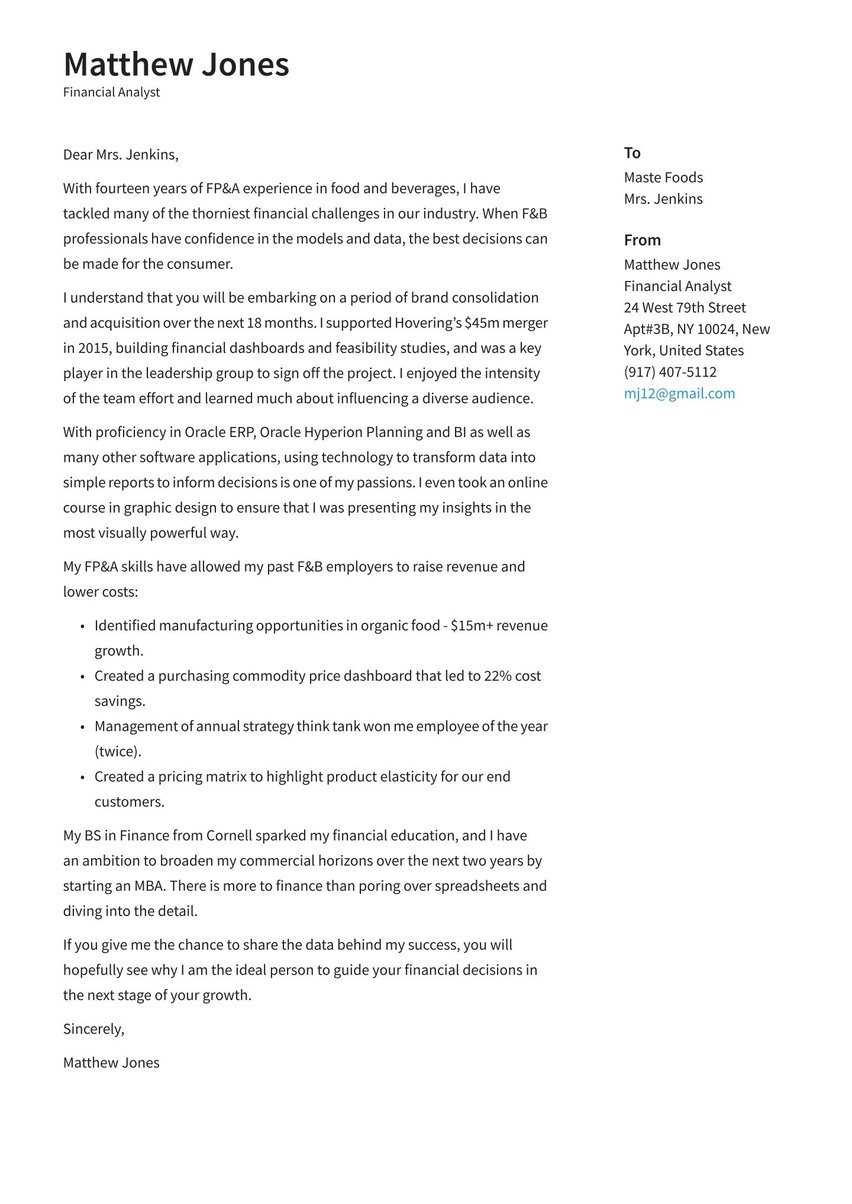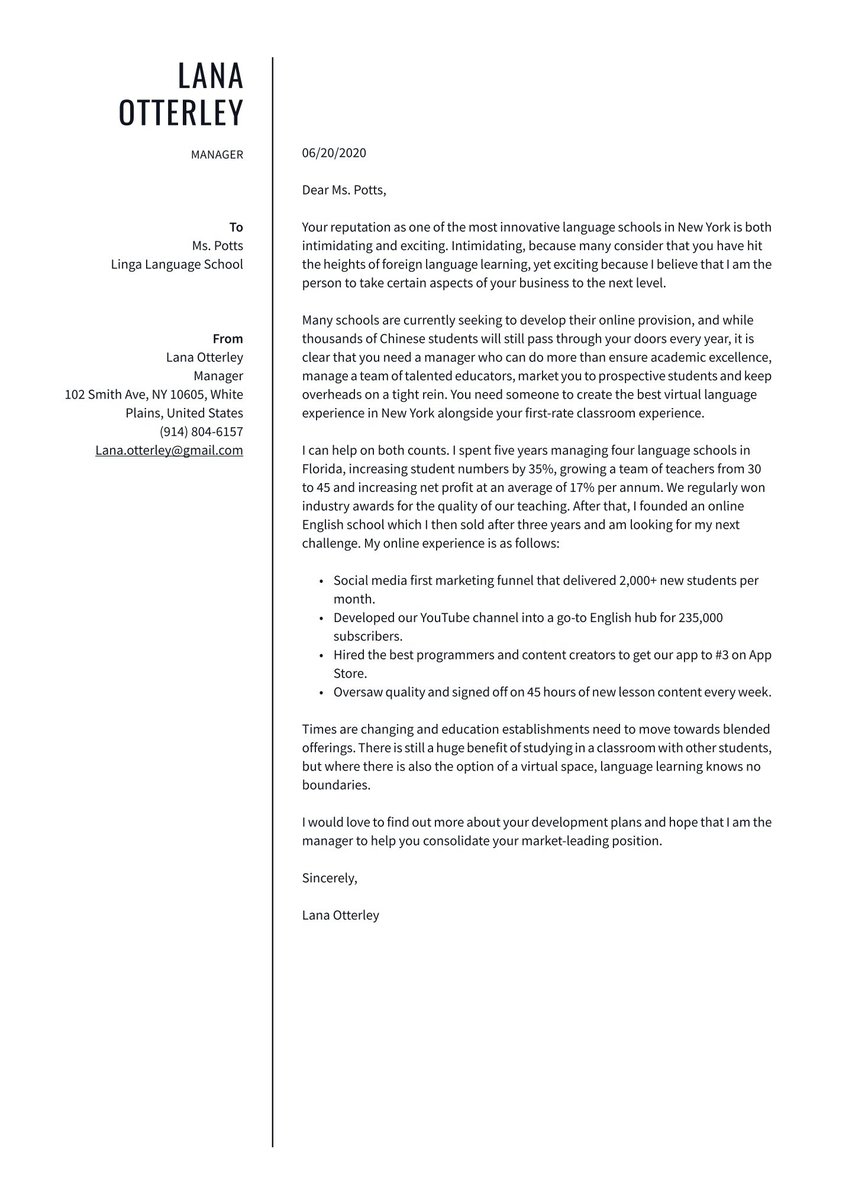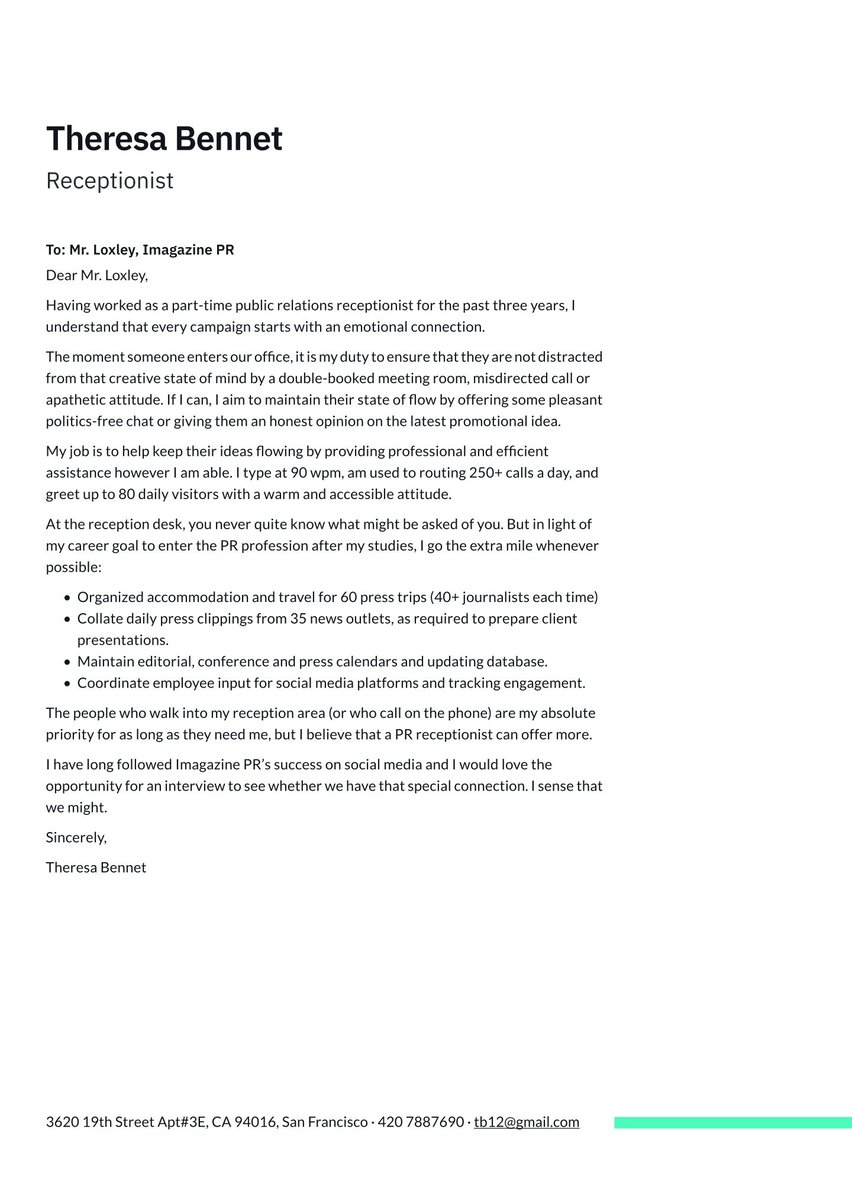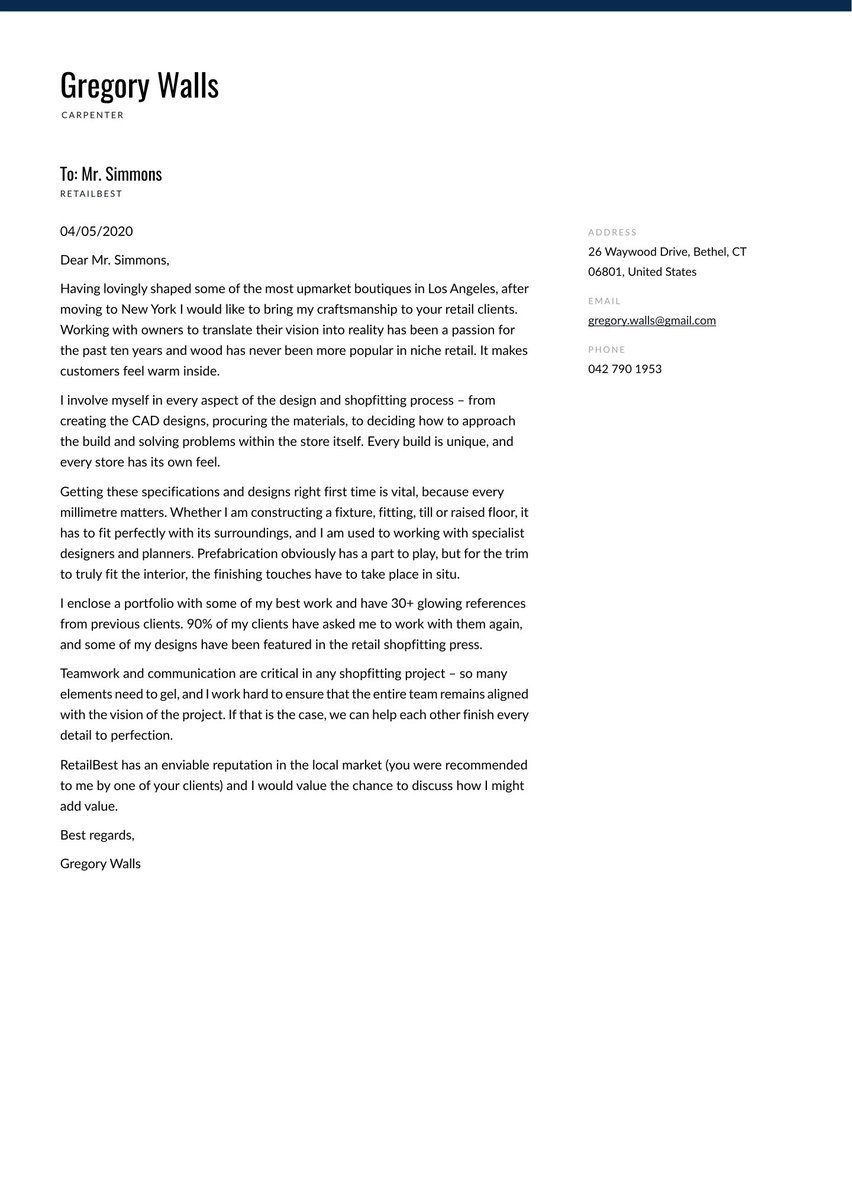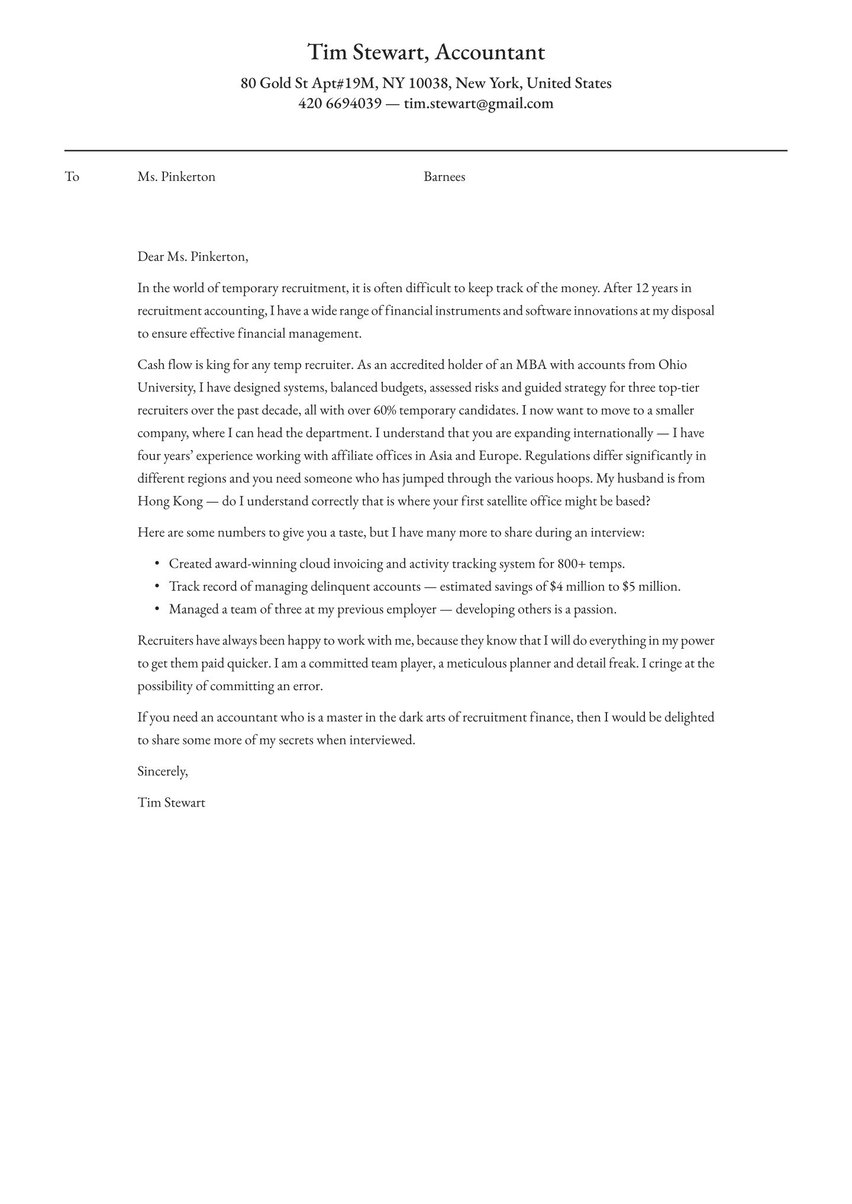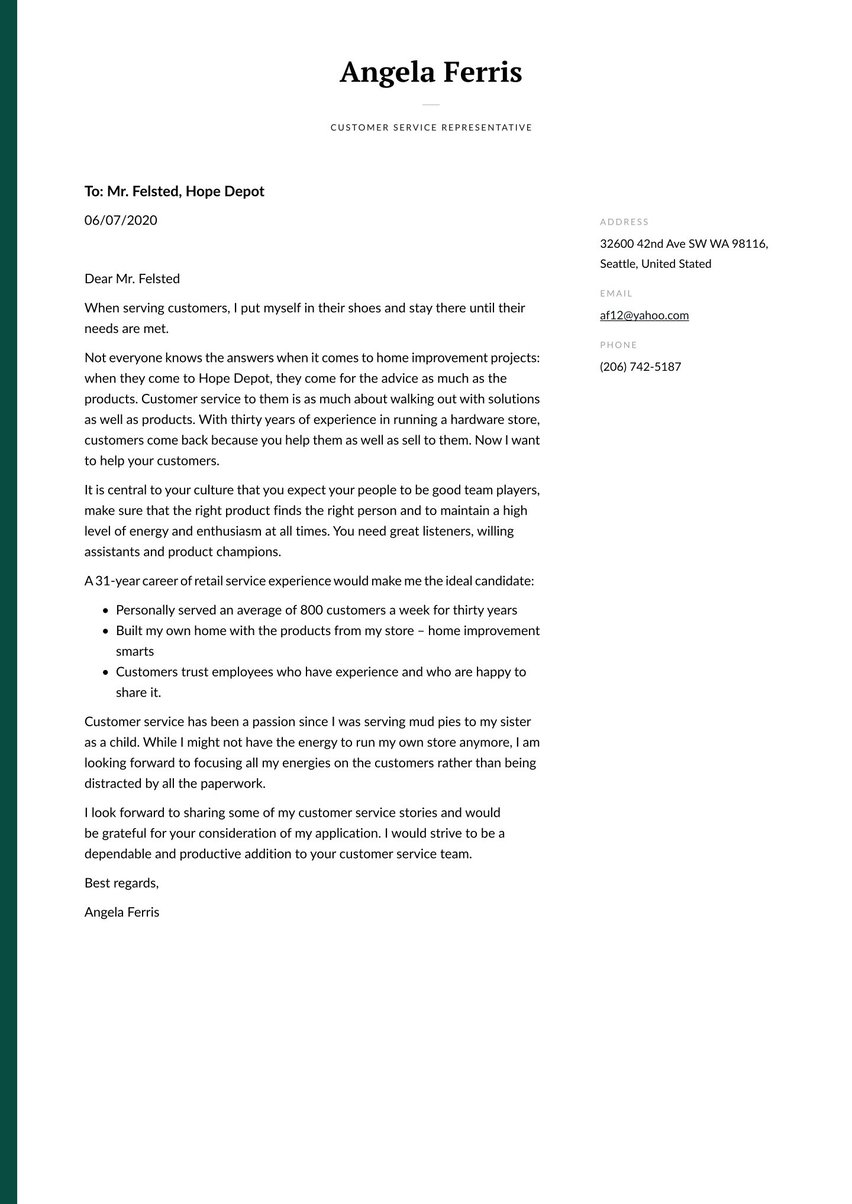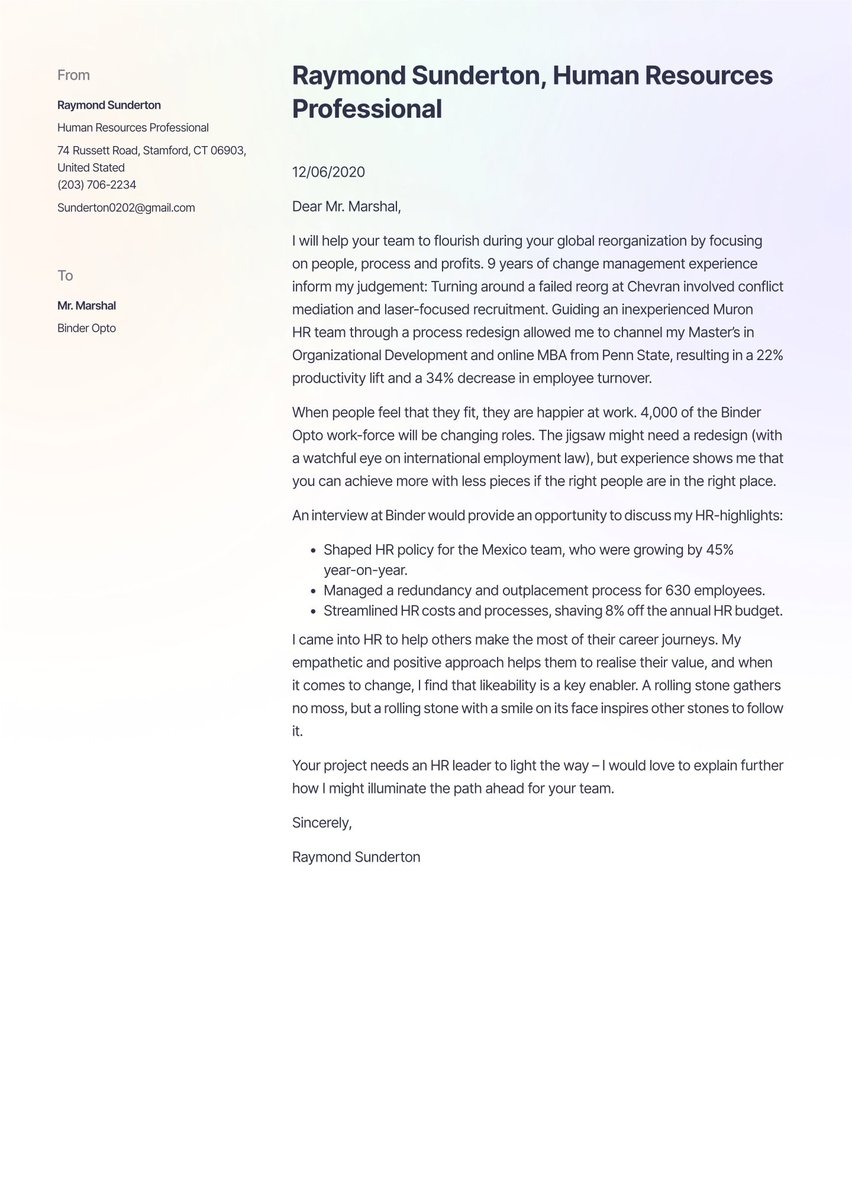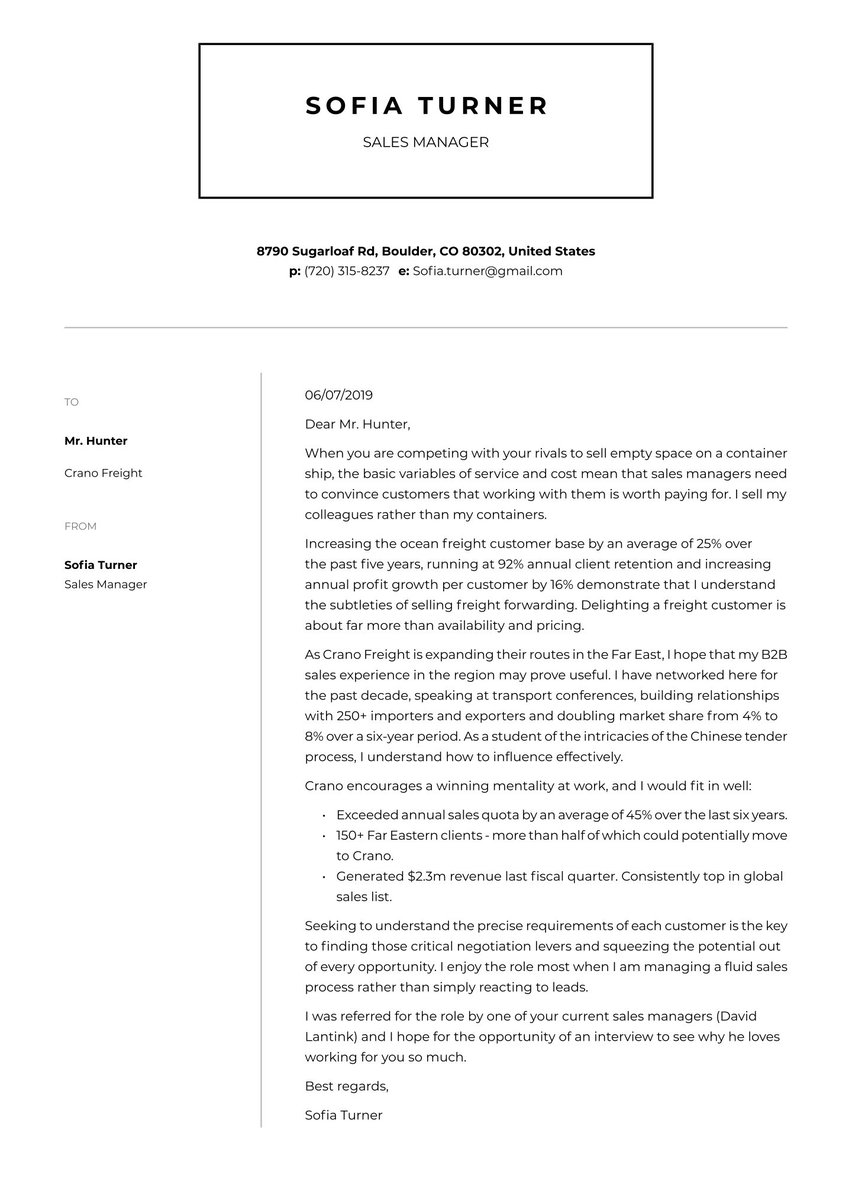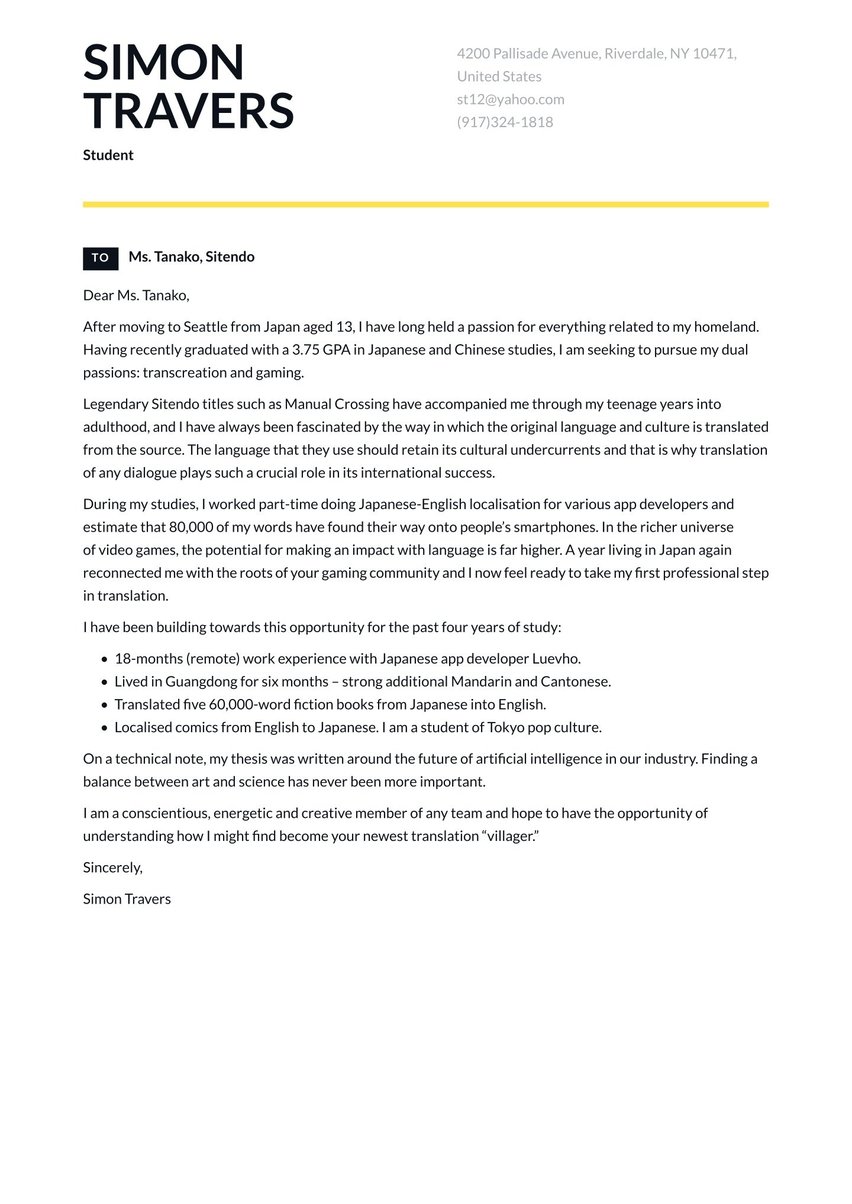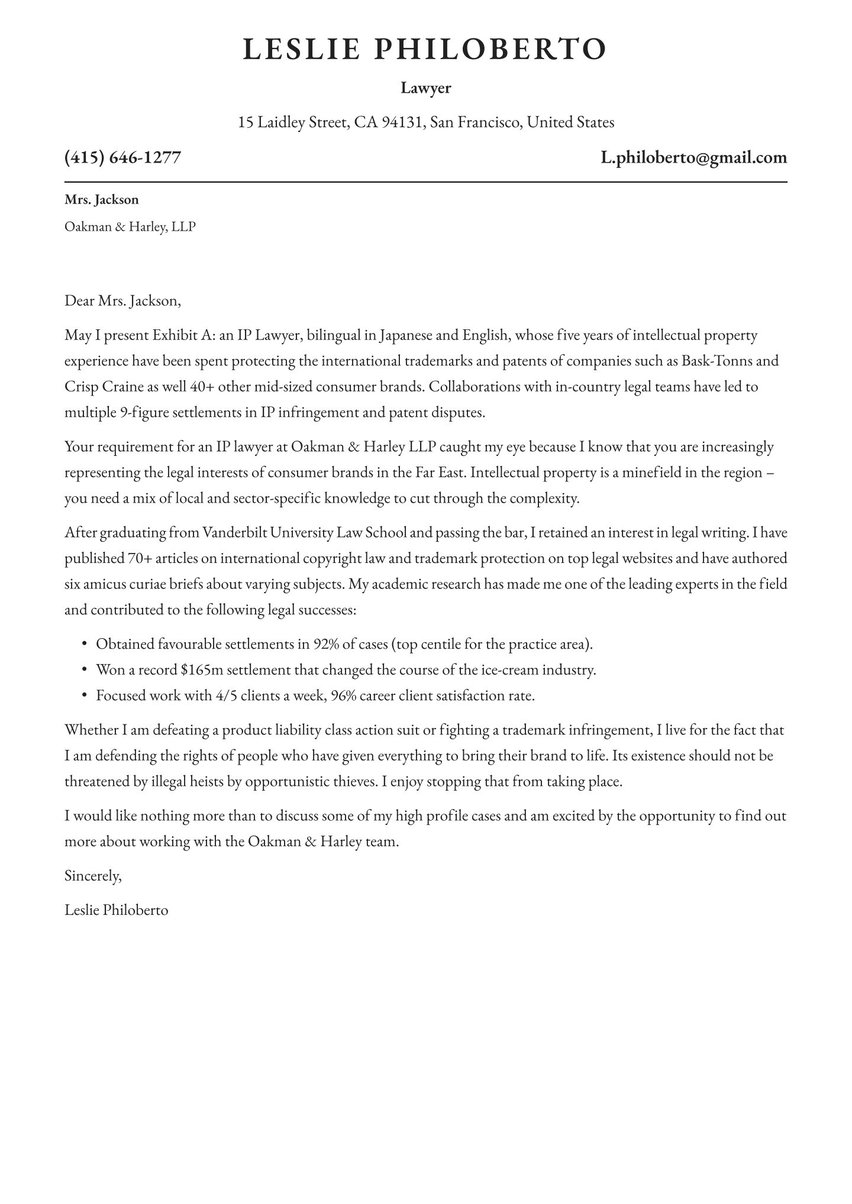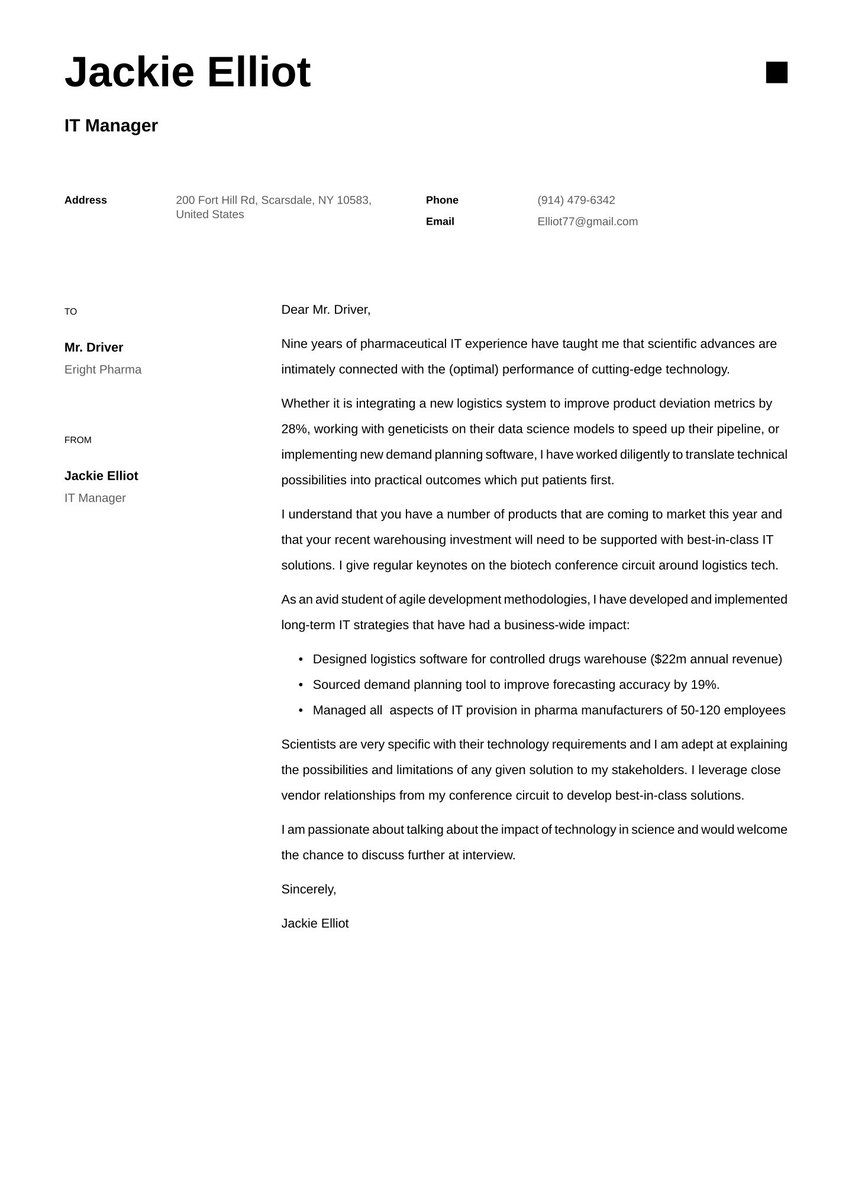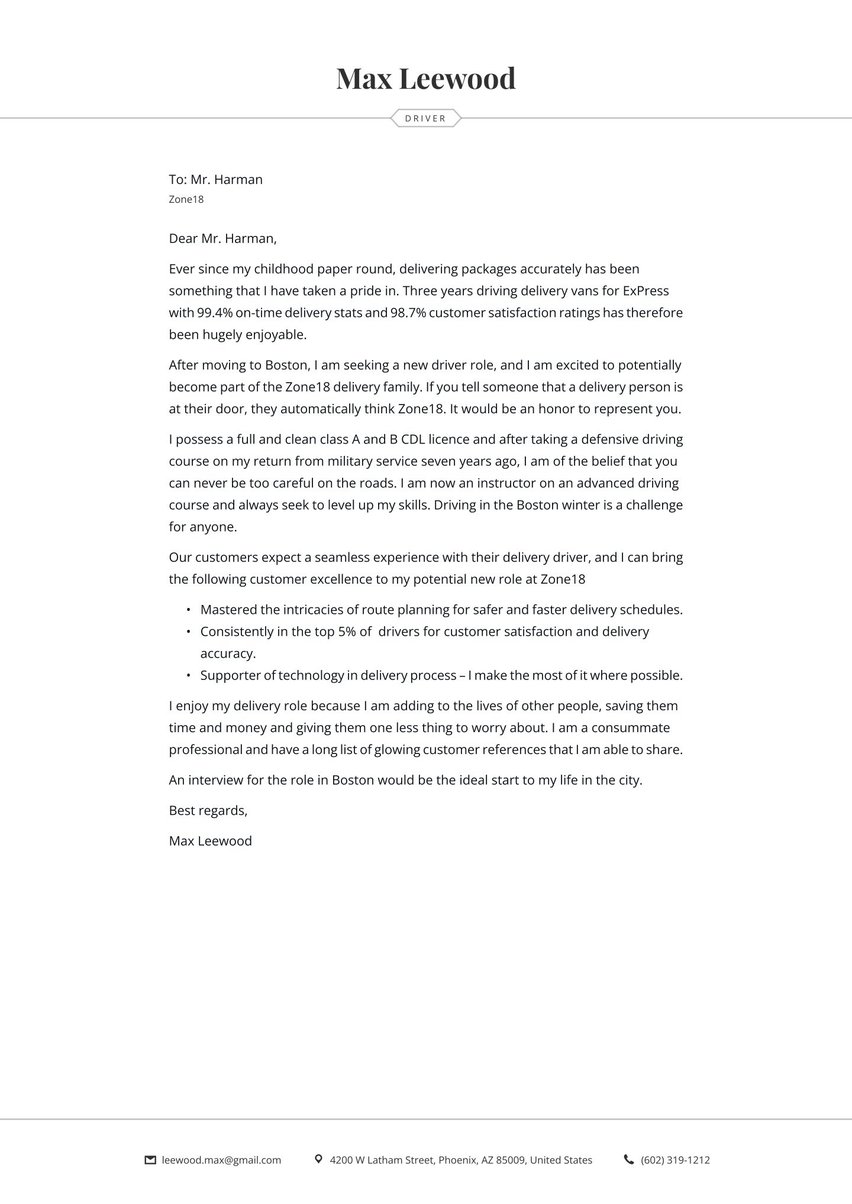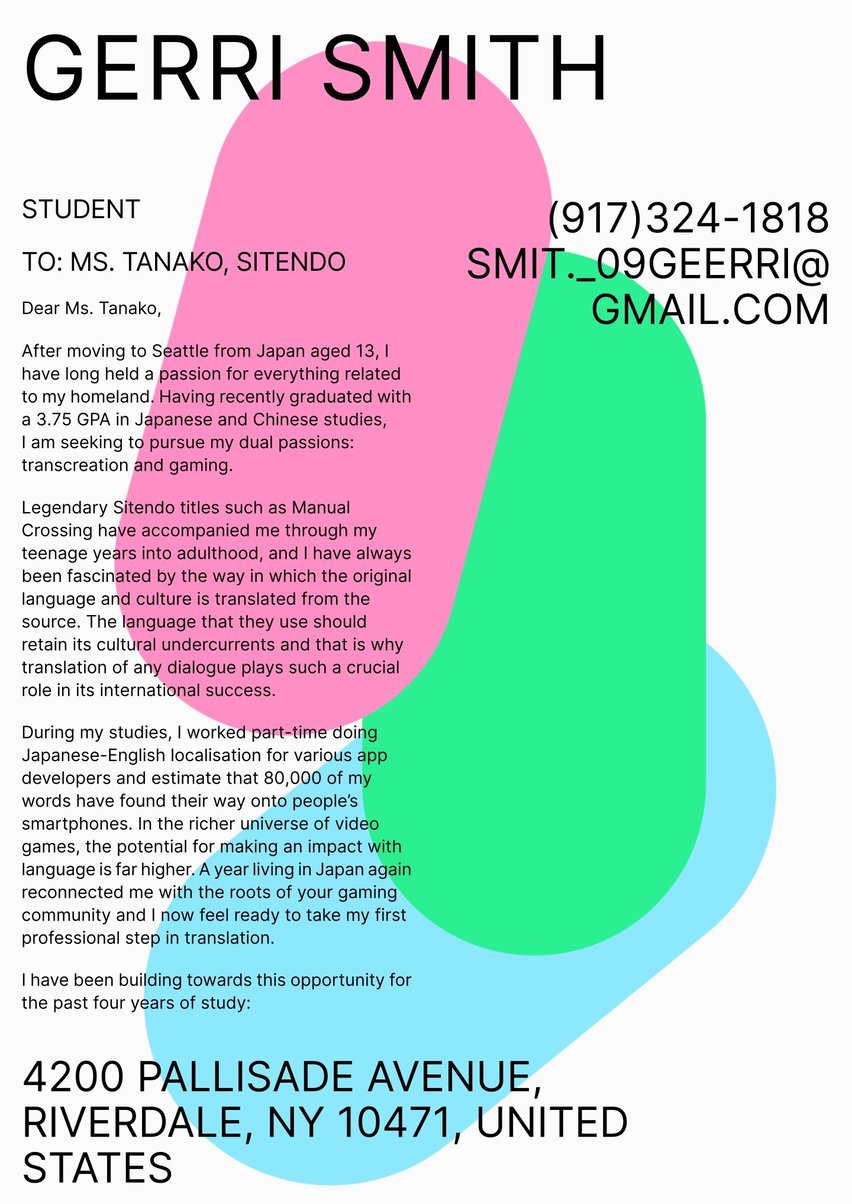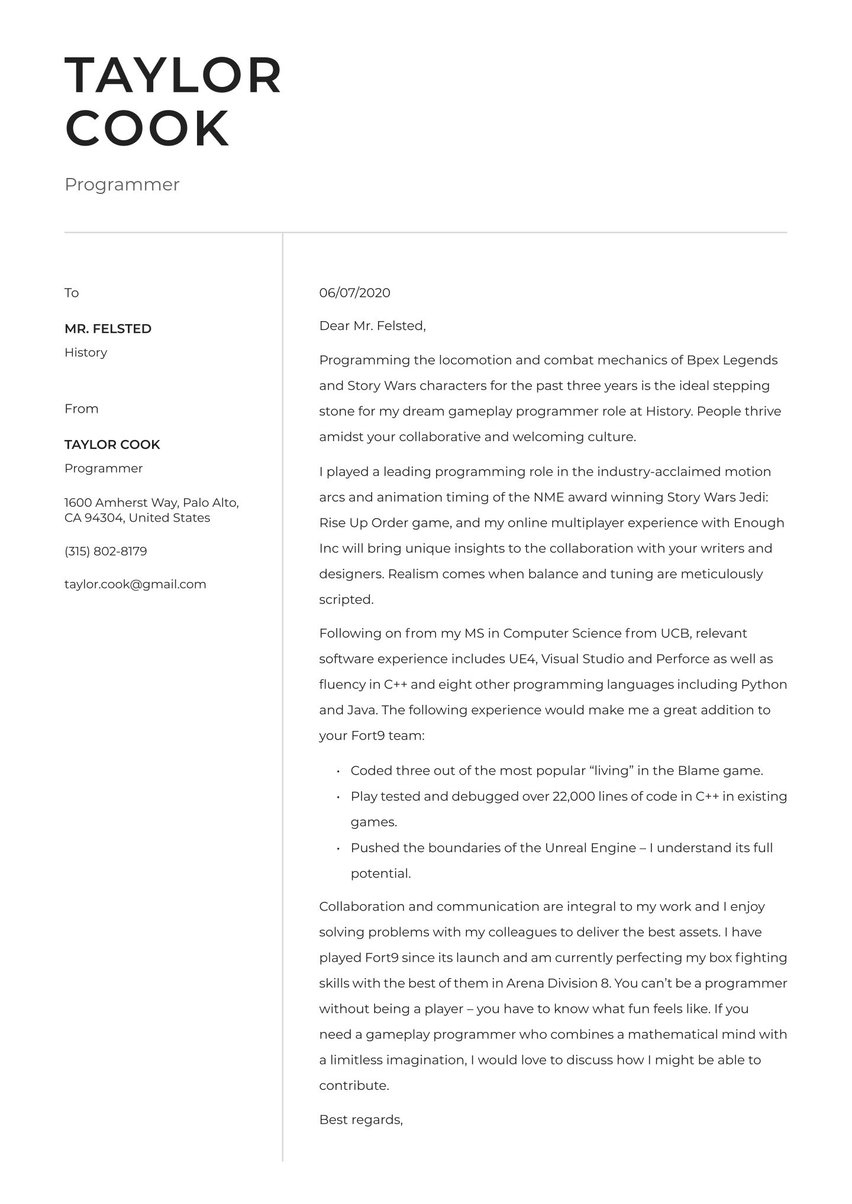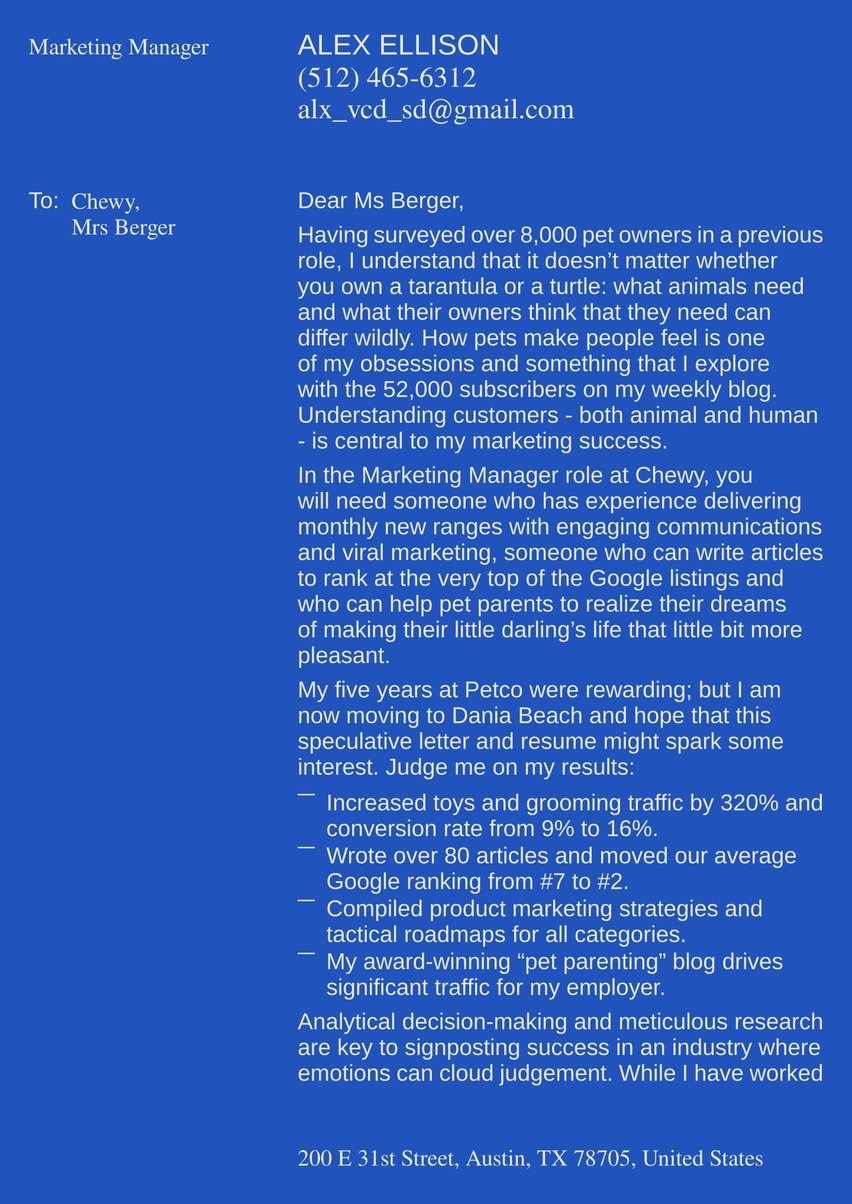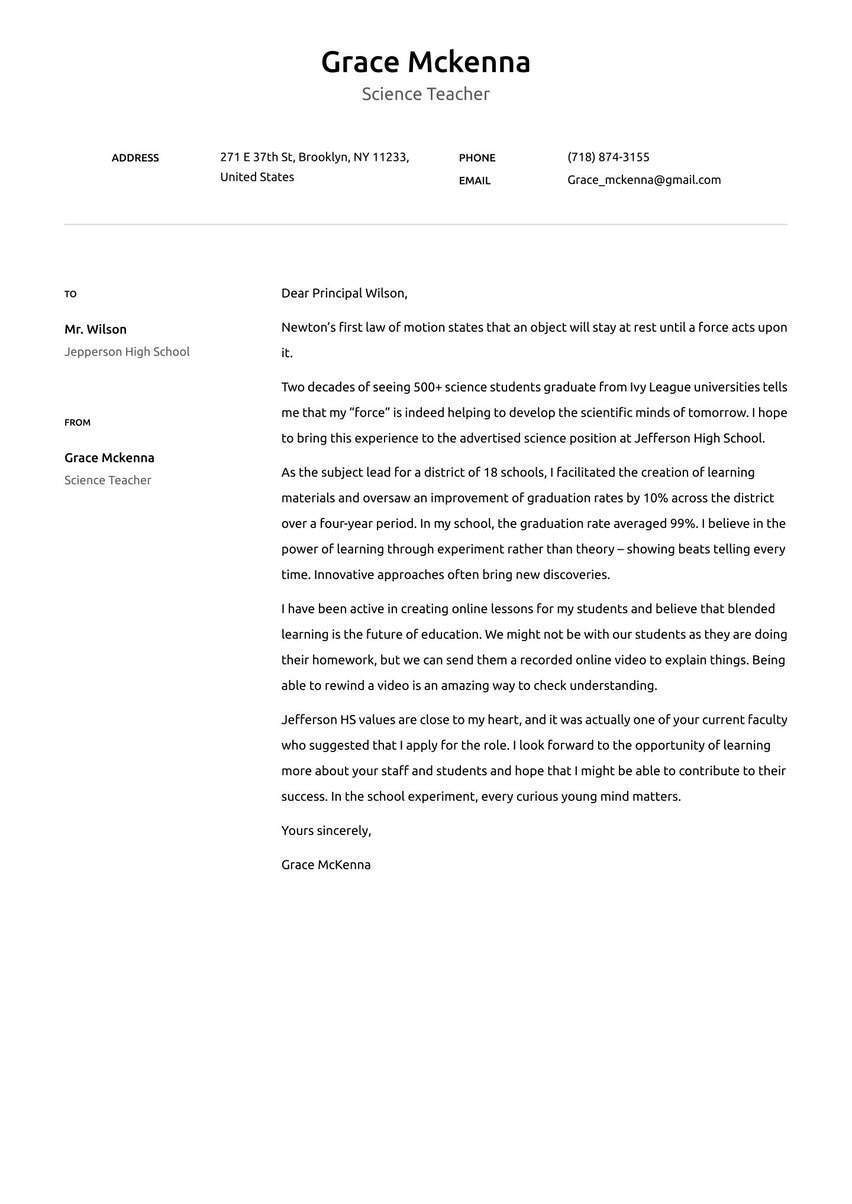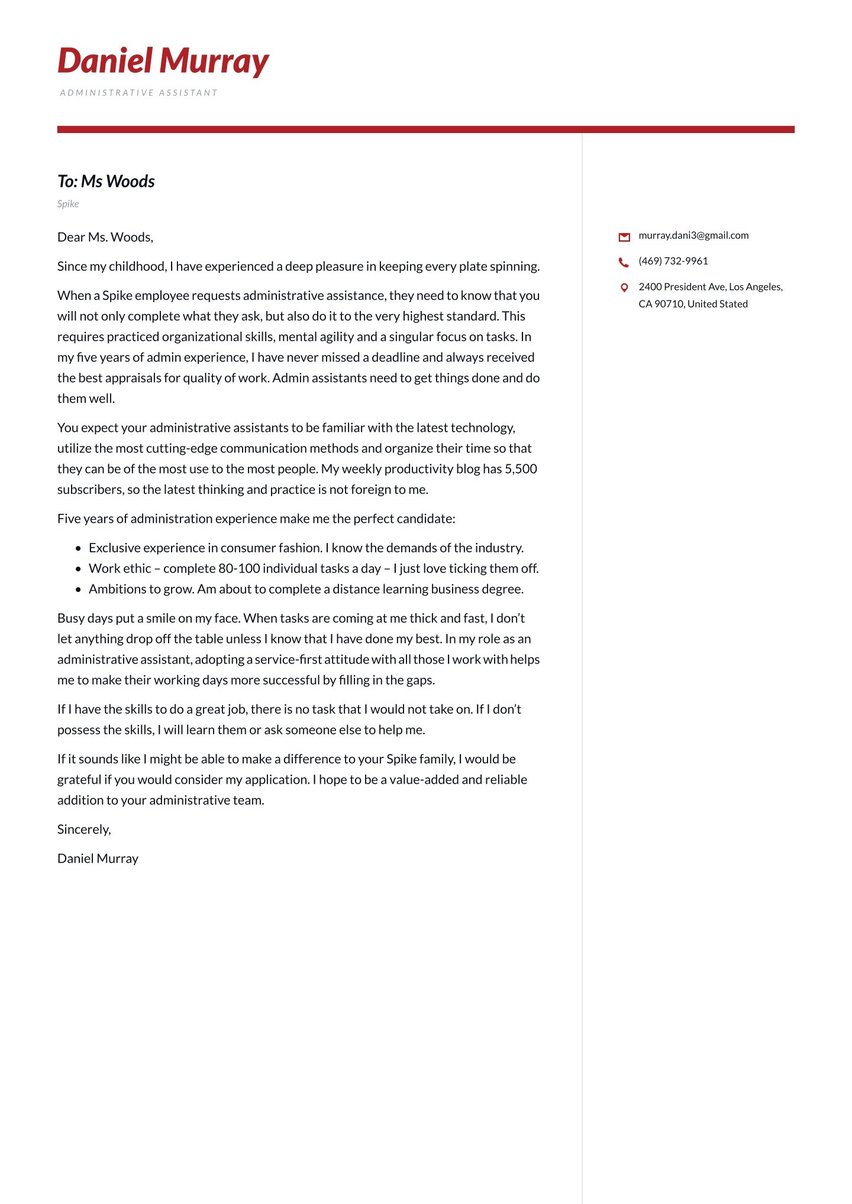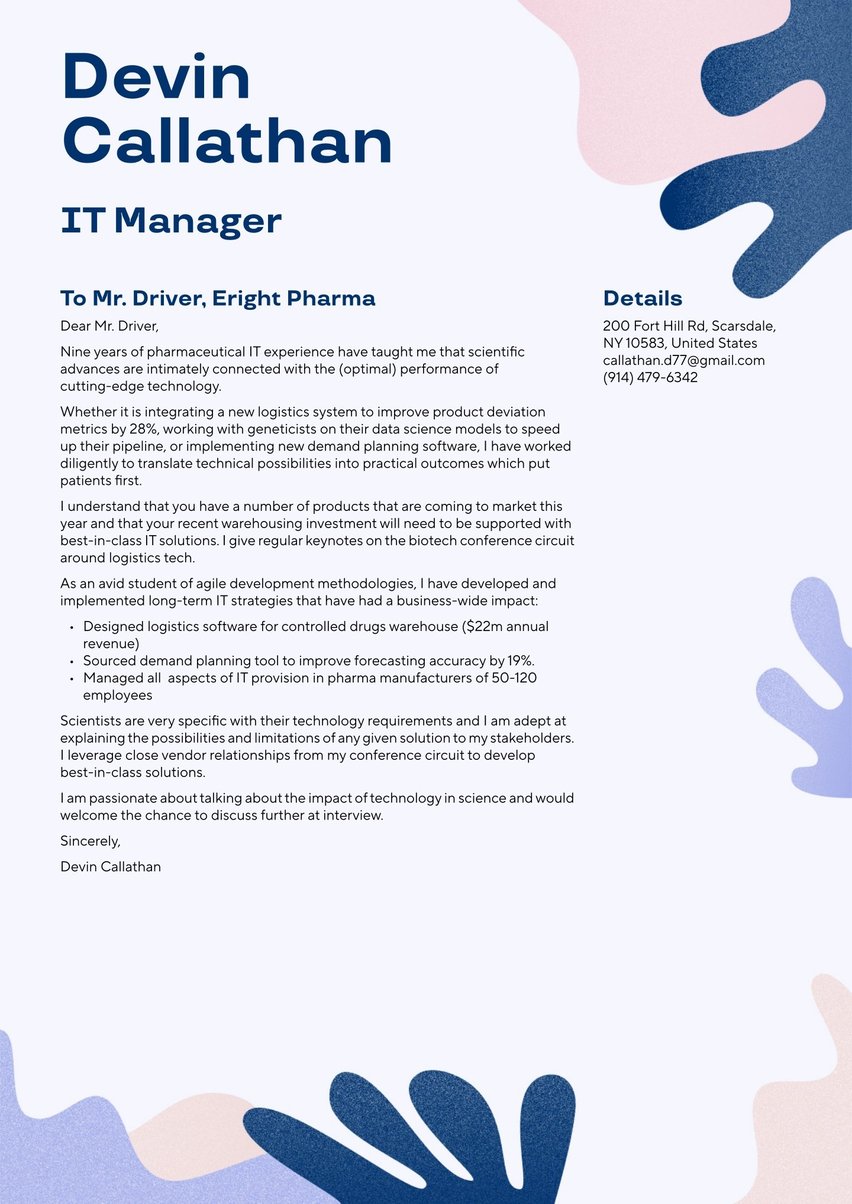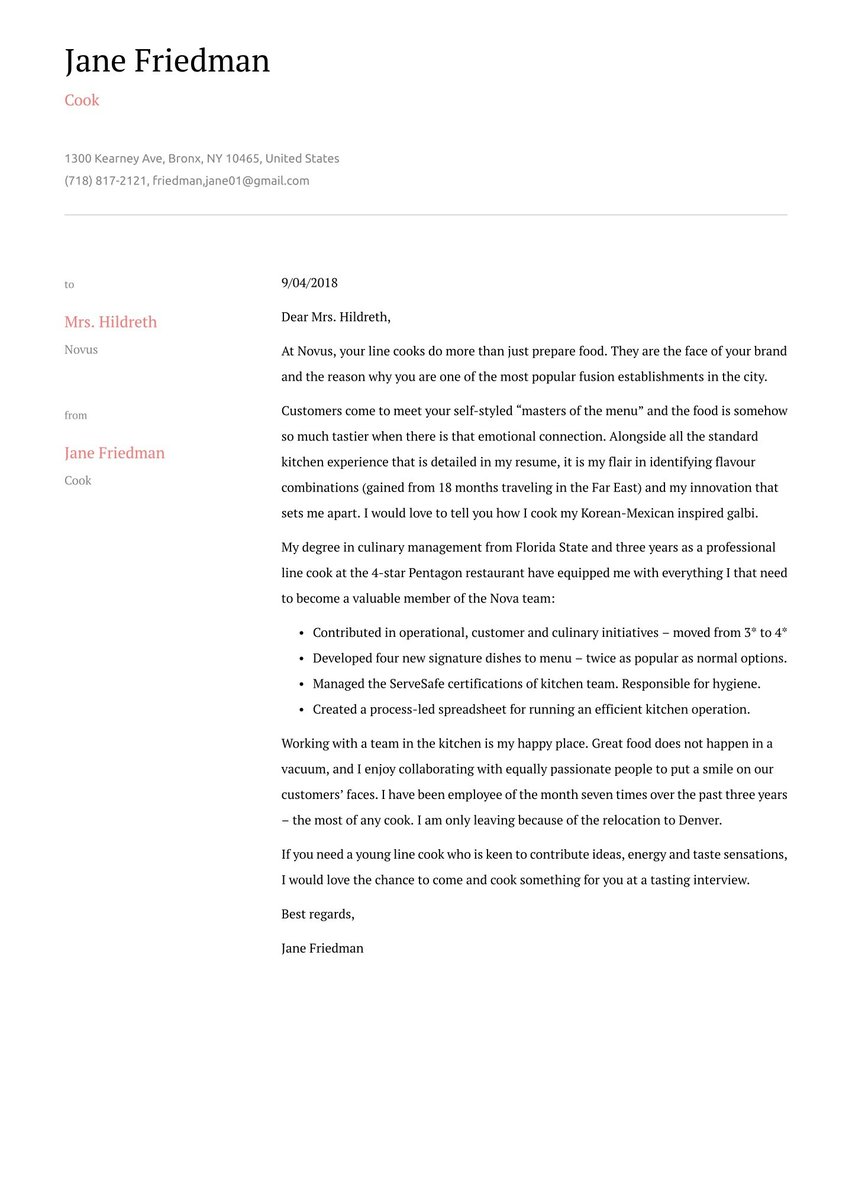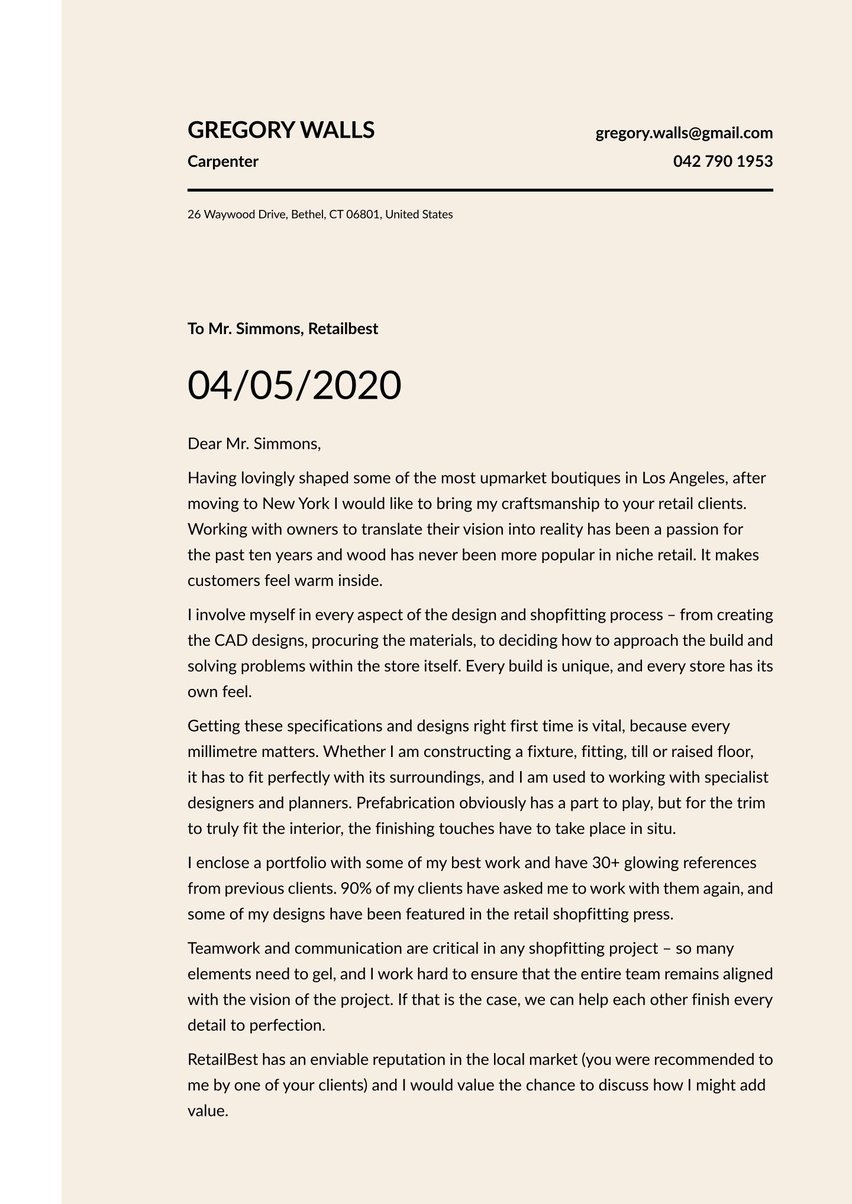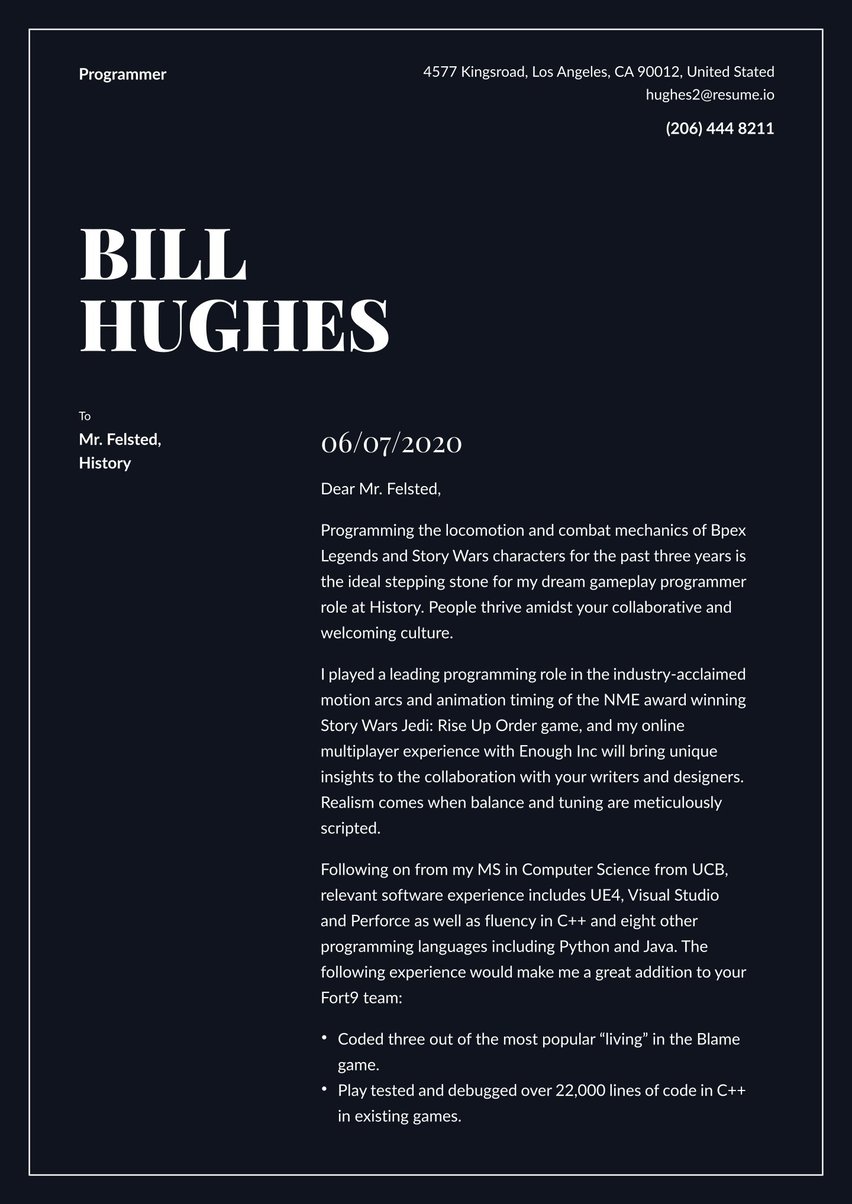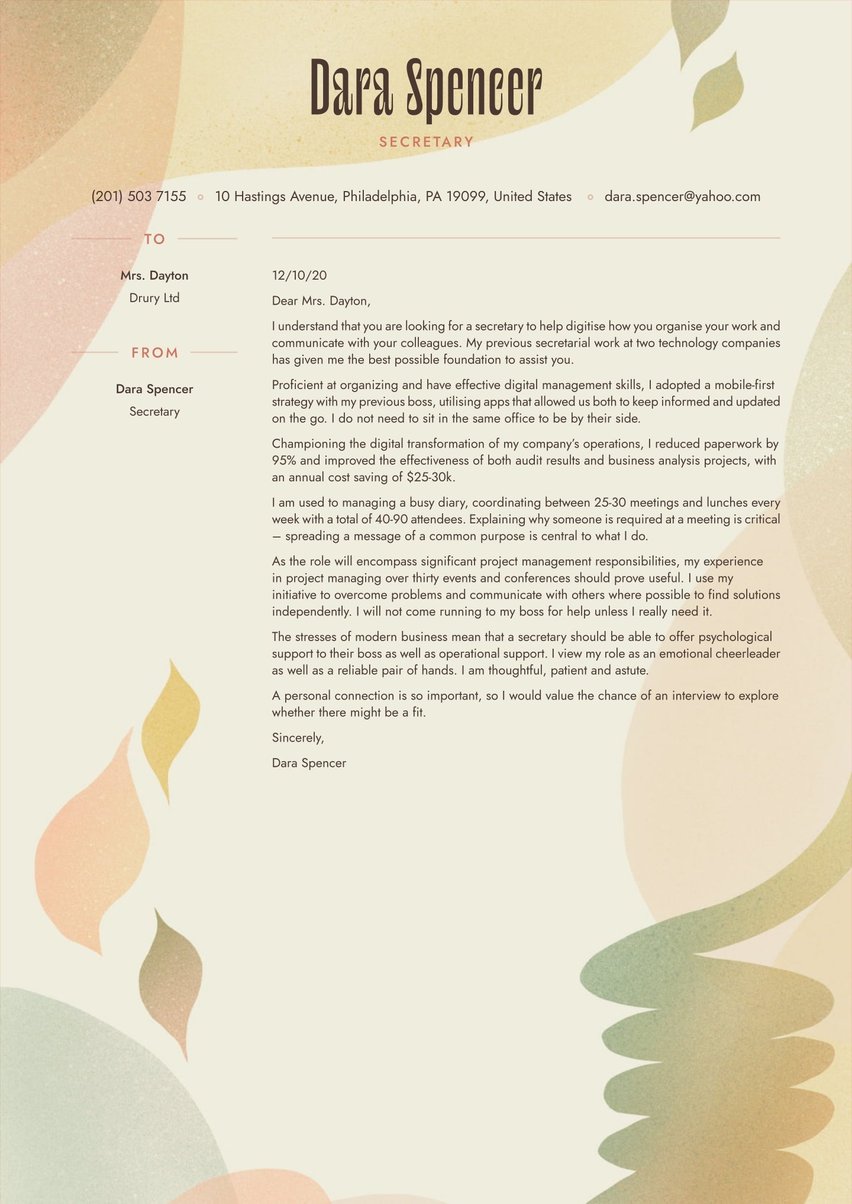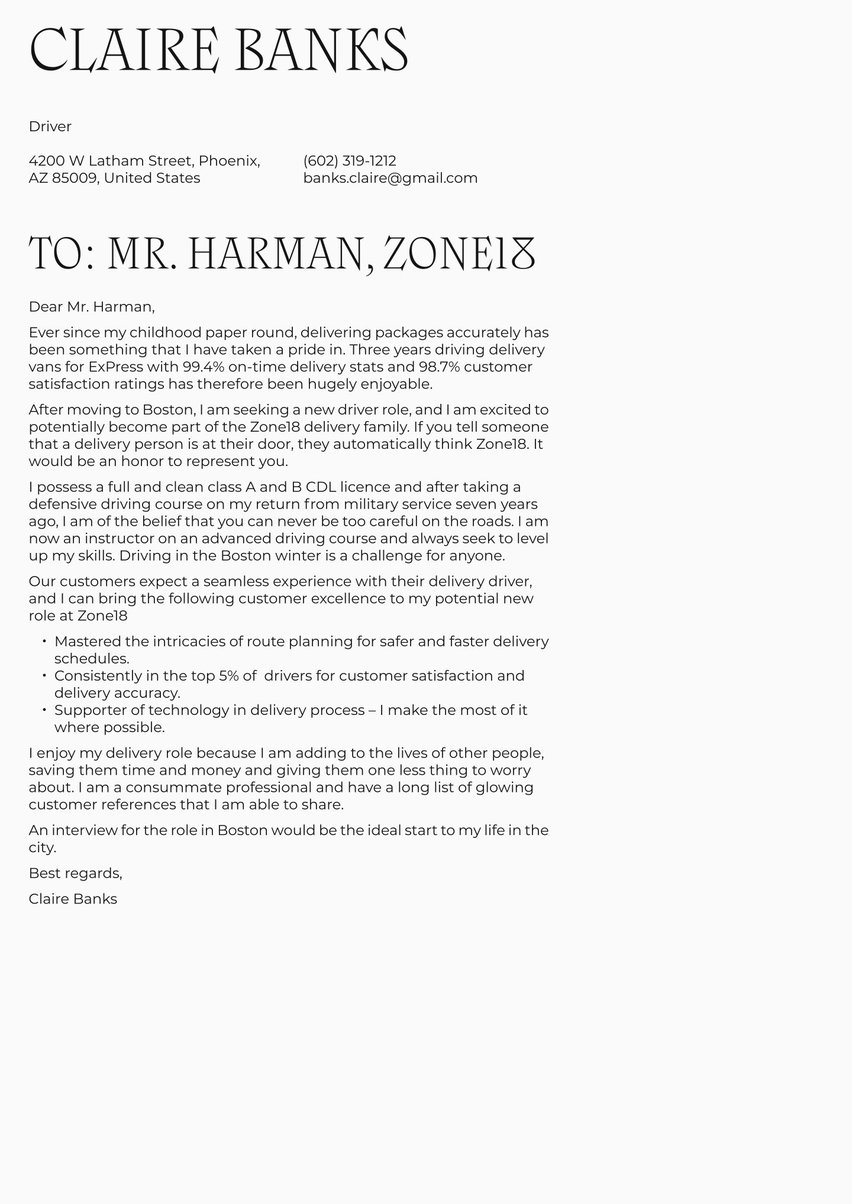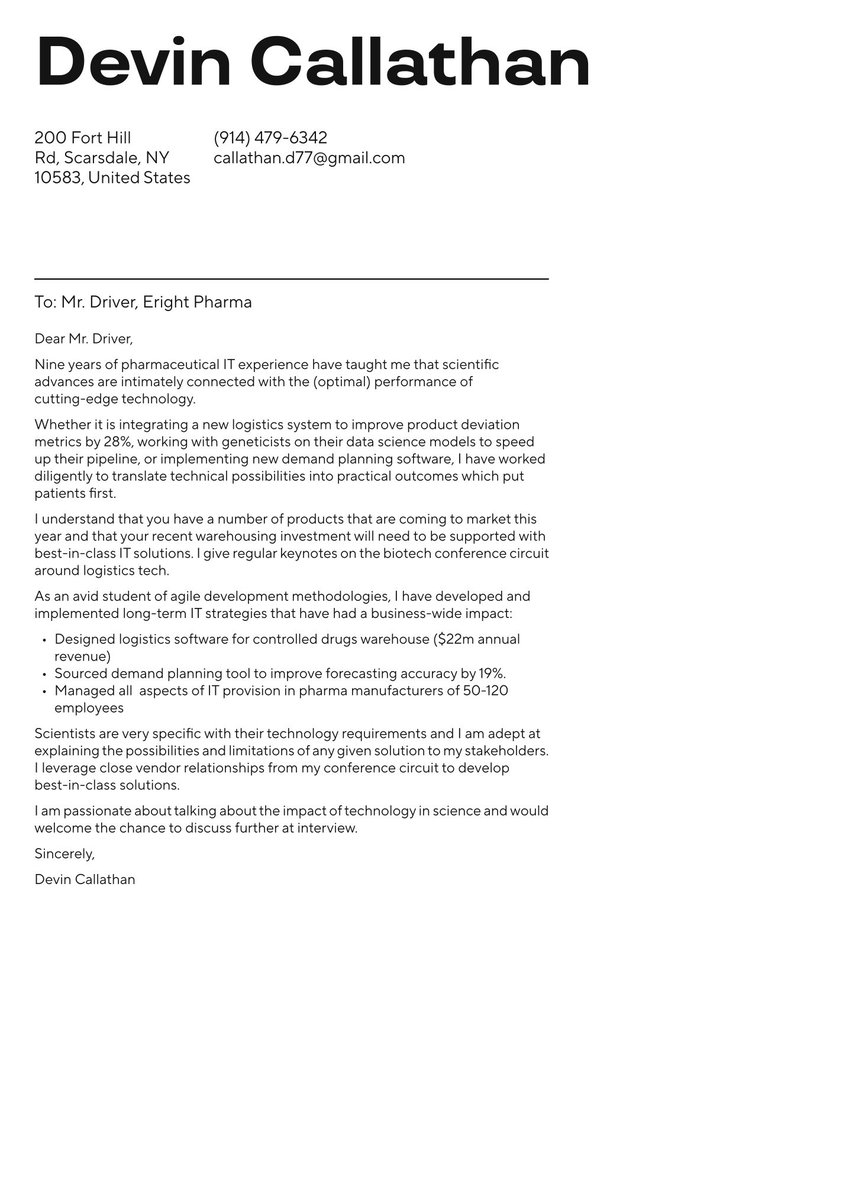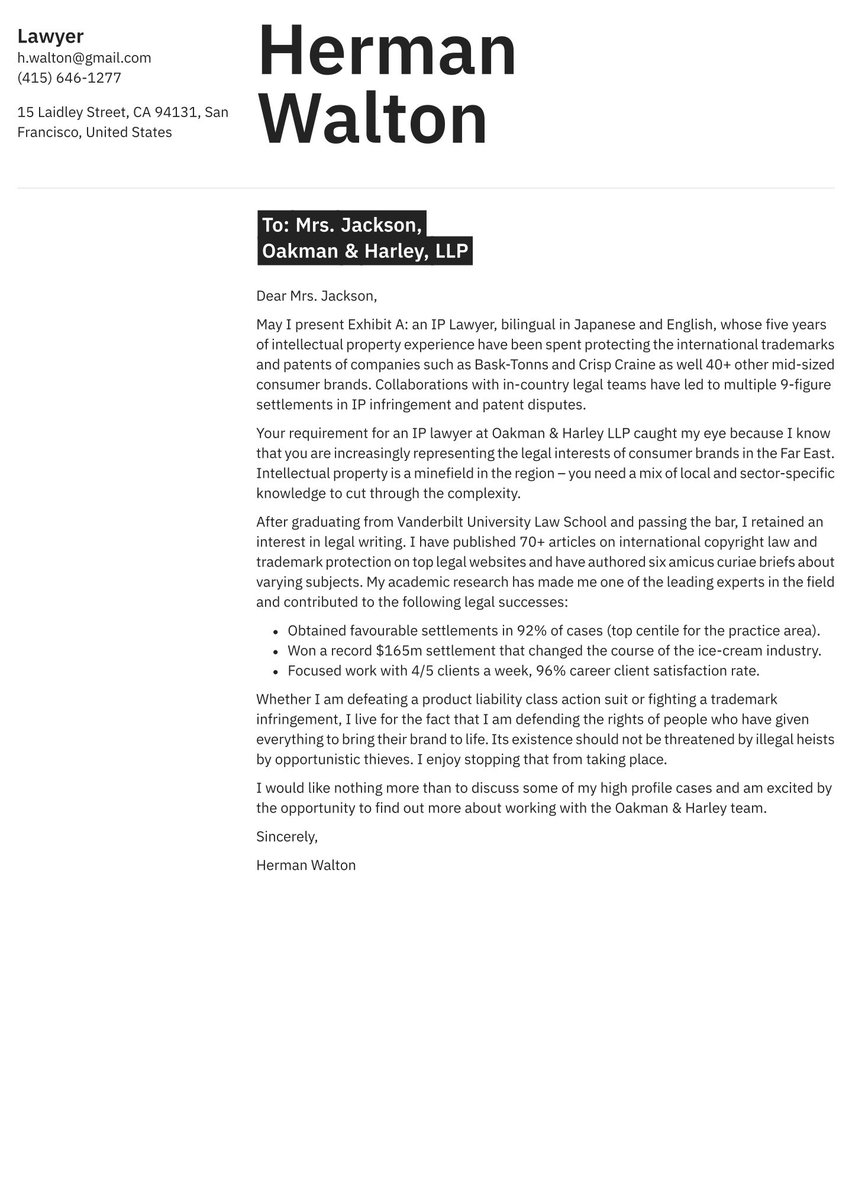A compelling production cover letter keeps your job hunt moving down the line. When hiring managers read it, their next stop is an email or phone call to you, to schedule that coveted interview.
In about 400 words, you have to convince your prospective boss that you can step into their open position and get things running smoothly. How do you accomplish that? Resume.io is here to help.
In this cover letter guide, along with the corresponding production cover letter example, we’ll cover the following topics to help you write the best cover letter possible:
- How to choose the best cover letter format and what paragraphs the cover letter should include
- How to maximize the effect of each cover letter paragraph (header, greeting, intro, body and conclusion)
- What approach to take when writing your cover letter
- What mistakes to avoid when writing your production cover letter.
So, what will set production professionals apart from other candidates? How do you write a convincing letter that clearly states your message and highlights your career? The guide below will analyze the details (you can also check out our library of 125+ cover letter examples.)
Manufacturing plays an important role in the economy, and there were 12.2 million manufacturing jobs in the U.S. at the beginning of 2021, The Balance reports. So take pride in your work and having that shine through in your cover letter.
Best format for a production cover letter
The best production systems stick to clear processes and structures. The best cover letters do the same. Before you get started compiling your letter, you should know what those are.
The format of a production cover letter should contain the following elements:
- The cover letter header
- The greeting / salutation
- The cover letter intro
- The middle paragraphs (body of the letter)
- The ending paragraph of your cover letter (conclusion and call-to-action)
What’s the point of a cover letter when you have detailed your career on your production resume? The cover letter gives you a bit of breathing room to assure the hiring manager of your quality. Whether you work on the line, operate machinery or manage the operations, you have a chance here to sell your candidacy by revealing a bit about who you are.
Our comprehensive cover letter guide is a great read for general advice on writing cover letters, along with plenty of specific formatting advice.
The production cover letter example below gives an overview of how to create your own application:
Dear Mr. Romano,
It is with great enthusiasm that I hope to be considered as a candidate for the role in Production currently available at NextUp. I have been following the success of your company for several years, and I do believe that my background and experience will compliment your production procedures immensely. I understand the kind of in-depth knowledge and skills that this demanding position requires, and I can assure you that I have what it takes to achieve success in this role.
In my most recent position as a Supply Chain Manager for Office Tech in Philadelphia, I worked closely with suppliers to ensure best practices and procedures. Similarly to NextUp, Office Tech is one the area's main office technology suppliers. Keeping up with procurement, planning and scheduling in the organization was crucial to our success. In that position I effectively managed and oversaw the supply chain department, and handled vendor development, contract negotiation, production planning, and inventory control.
I fully understand the complex responsibilities that come along with the Supply Chain Manager role at NextUp, and I look forward to discussing how I can leverage and utilize my skills and experience for the betterment of the production department.
Best Regards,
John Swire
If you’re looking for additional inspiration for cover letter writing, you can check out our operations manager cover letter example.
Cover letter header
No matter how great your production cover letter is, if you make it difficult for a recruiter to contact you, they are likely to move on to the next candidate. That’s where the header comes in.
It is here that you list your name, email and phone contact information in a style that attracts attention. Align this style with the layout and font choice in your resume to create a coordinated job application.
Consider the ATS
You may know about Applicant Tracking Systems or ATS when it comes to resume writing, but don’t disregard that software in your cover letter either. Some ATS algorithms may take your cover letter text into account as well. We don’t recommend “stuffing” your letter with keywords and phrases, but do keep them in mind as you write.
The aim of this section: Make it easy for recruiters to find your contact information and develop a memorable design style that you will use throughout your application.
Cover letter greeting
The first goal of your production cover letter is to create a rapport with the hiring manager or your prospective boss. The easiest way to do that is to address them by name with a friendly, and professional greeting.
Our cover letter samples typically begin with “Dear Mr/Mrs/Ms. Surname” because that opening treads the line of being both personal and business-like. We recommend you do the same, but be careful to triple check that you have the spelling and honorific correct.
If you cannot discover the name of the person responsible for hiring, you may use something to the effect of “Dear (Company Name) Hiring Team.” Avoid “To Whom It May Concern” whenever possible since it can come across as outdated and impersonal.
The aim of the cover letter greeting: Set a friendly but business-like tone for your production cover letter.
Dear Mr. Romano,
Cover letter introduction
Your job here is to build excitement in your candidacy by introducing yourself and your career with strong descriptive and action words. You are not just a machine tool programmer, you are a highly experienced machine tool programmer with expertise in metal processing.
Do some research into the company you are targeting in your production cover letter so that you can choose career highlights that illustrate how you will step into your new role. Find out what machinery and software they use, how the business is structured and how much they produce. Directly address the company’s processes in your letter.
Intrigue the hiring manager with your knowledge and experience or they won’t have a reason to read on.
The aim of the cover letter intro: Show that you have the talent to step into the role you desire and offer a career highlight that inspires the hiring manager to read on.
It is with great enthusiasm that I hope to be considered as a candidate for the role in Production currently available at NextUp. I have been following the success of your company for several years, and I do believe that my background and experience will compliment your production procedures immensely. I understand the kind of in-depth knowledge and skills that this demanding position requires, and I can assure you that I have what it takes to achieve success in this role.
Cover letter middle part (body)
The middle part or body of your production cover letter builds onto your message by adding all the best of your career. You have two or three paragraphs to explain how you make a difference with your dedication. Choose to highlight your biggest attributes, including soft skills such as your ability to problem-solve, work well with others and your reliability.
If you can’t clearly explain what makes you a great candidate, you’re unlikely to get hired.
Your career highlights should relate as closely as possible to the work you will do in your prospective new position. Show that you can work under time pressure or when the production line breaks down. Hiring managers want workers who can rise to the occasion, not just those that can operate when everything is going smoothly.
Use bullets to list 3-4 successes within the body paragraphs of your letter. This serves two purposes:
- Add emphasis to your career achievements
- Break up big blocks of type that can be daunting to read
The cover letter sample text below offers one method for achieving this.
The aim of the body of your cover letter: Cement your case by using strong details from your work history to show you know how to do the job.
In my most recent position as a Supply Chain Manager for Office Tech in Philadelphia, I worked closely with suppliers to ensure best practices and procedures. Similarly to NextUp, Office Tech is one the area's main office technology suppliers. Keeping up with procurement, planning and scheduling in the organization was crucial to our success. In that position I effectively managed and oversaw the supply chain department, and handled vendor development, contract negotiation, production planning, and inventory control.
How to close a production cover letter (conclusion and sign-off)
The closing is the time to put the finishing touches on your application. You’re basic product is already on the page, but you need to polish it up. You do that by reminding the hiring manager of your answer to the question, “Why should I hire you?”
Once you’ve done that, the conclusion gives you a sentence or two to add a personal touch. Give an anecdote about your work life that didn’t fit in anywhere else or tell about a hobby you have that enhances your candidacy or offers a more rounded picture of who you are.
FInally, add a call to action, also known as a request for an interview. Our cover letter sample has wording you can use, or use your own language to convey your interest.
The aim of the close of your cover letter: Remind the hiring manager that you really want the job and restate your message.
I fully understand the complex responsibilities that come along with the Supply Chain Manager role at NextUp, and I look forward to discussing how I can leverage and utilize my skills and experience for the betterment of the production department.
Best Regards,
John Swire
Production cover letter with no experience
You may not have any direct experience in production, but we bet you have worked, even if it was part-time after school. Even if you haven’t, you can use your experiences in classes or in extracurricular activities to show you have basic job skills.
Employers who hire for entry-level positions are looking for your soft skills. Those are non-technical abilities it takes to be a reliable employee. Think about how you can demonstrate your communication or collaborative nature through activities you have participated in. Our cover letter sample will help guide you.
Another tactic you can use is explaining why you want the job – and why you want the job at the specific company you are writing to. Add a sentence or two on how you plan to get up to speed quickly and become an asset to the organization. You may also want to add in your career goals.
Basic mistakes in a production application letter (and how to avoid them)
- You don’t state your case clearly enough. You need to connect the dots for your future employer. Don’t assume they know how your skill at one job will help them. Spell it out.
- Speaking of spelling … get it right! You have the tools to spell everything correctly. If you’re unsure of spelling or grammar, have a friend or colleague help.
- Keep stories brief. If you have to go into a long explanation for your achievement to make sense, save it for the interview.
A well-organized and attractive page layout for your cover letter can quickly make you stand out from other candidates. While your design doesn’t need to be complicated, a polished and simple format can go a long way. A professionally-designed cover letter template can make this easy.
Key takeaways for a production cover letter
- Use strong descriptive and action words to show off your career highlights and work style.
- Choose achievements that will show your prospective employer that you can do the job they need to fill.
- Make sure you discuss soft skills as well as your technical knowledge.
- Check out our production cover letter sample for more ideas on creating a great page layout.


